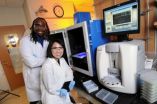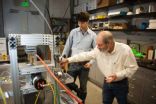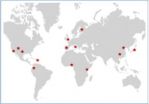(Press-News.org) Predicting how atherosclerosis, osteoporosis or cancer will progress or respond to drugs in individual patients is difficult. In a new study, researchers took another step toward that goal by developing a technique able to predict from a blood sample the amount of cathepsins—protein-degrading enzymes known to accelerate these diseases—a specific person would produce.
This patient-specific information may be helpful in developing personalized approaches to treat these tissue-destructive diseases.
"We measured significant variability in the amount of cathepsins produced by blood samples we collected from healthy individuals, which may indicate that a one-size-fits-all approach of administering cathepsin inhibitors may not be the best strategy for all patients with these conditions," said Manu Platt, an assistant professor in the Wallace H. Coulter Department of Biomedical Engineering at Georgia Tech and Emory University.
The study was published online on Oct. 19, 2012 in the journal Integrative Biology. This work was supported by the National Institutes of Health, Georgia Cancer Coalition, Atlanta Clinical and Translational Science Institute, and the Emory/Georgia Tech Regenerative Engineering and Medicine Center.
Platt and graduate student Keon-Young Park collected blood samples from 14 healthy individuals, removed white blood cells called monocytes from the samples and stimulated those cells with certain molecules so that they would become macrophages or osteoclasts in the laboratory. By doing this, the researchers recreated what happens in the body—monocytes receive these cues from damaged tissue, leave the blood, and become macrophages or osteoclasts, which are known to contribute to tissue changes that occur in atherosclerosis, cancer and osteoporosis.
Then the researchers developed a model that used patient-varying kinase signals collected from the macrophages or osteoclasts to predict patient-specific activity of four cathepsins: K, L, S and V.
"Kinases are enzymes that integrate stimuli from different soluble, cellular and physical cues to generate specific cellular responses," explained Platt, who is also a Georgia Cancer Coalition Distinguished Cancer Scholar. "By using a systems biology approach to link cell differentiation cues and responses through integration of signals at the kinase level, we were able to mathematically predict relative amounts of cathepsin activity and distinguish which blood donors exhibited greater cathepsin activity compared to others."
Predictability for all cathepsins ranged from 90 to 95 percent for both macrophages and osteoclasts, despite a range in the level of each cathepsin among the blood samples tested.
"We were pleased with the results because our model achieved very high predictability from a simple blood draw and overcame the challenge of incorporating the complex, unknown cues from individual patients' unique genetic and biochemical backgrounds," said Platt.
According to Platt, the next step will be to assess the model's ability to predict cathepsin activity using blood samples from individuals with the diseases of interest: atherosclerosis, osteoporosis or cancer.
"Our ultimate goal is to create an assay that will inform a clinician whether an individual's case of cancer or other tissue-destructive disease will be very aggressive from the moment that individual is diagnosed, which will enable the clinician to develop and begin the best personalized treatment plan immediately," added Platt.
INFORMATION:
Weiwei A. Li, who received her bachelor's degree from the Coulter Department in 2010, also contributed to this study.
Research reported in this publication was supported in part by the National Center for Advancing Translational Sciences of the National Institutes of Health (NIH) under award number UL1TR000454 and the Office of the Director of the NIH under award number 1DP2OD007433. The content is solely the responsibility of the principal investigators and does not necessarily represent the official views of the NIH.
CITATION: Park, Keon-Young et al., "Patient specific proteolytic activity of monocyte-derived macrophages and osteoclasts predicted with temporal kinase activation states during differentiation," Integrative Biology (2012): http://dx.doi.org/10.1039/C2IB20197F.
Researchers use blood testing to predict level of enzymes that facilitate disease progression
Cathepsin prediction
2012-11-01
ELSE PRESS RELEASES FROM THIS DATE:
Mice with 'humanized' livers improve early drug testing, Stanford scientists show
2012-11-01
STANFORD, Calif. — Stanford University School of Medicine scientists have used bioengineered mice with livers composed largely of human cells to characterize a drug about to enter early-stage clinical development for combating hepatitis C.
Tests using the new mouse model accurately predicted significant aspects of the drug's behavior in humans — including its interaction with another drug and the profile of its major breakdown products in the body (called metabolites) — far more accurately than would have been achieved using current methods.
The study will be published ...
Regional analysis masks substantial local variation in health care spending
2012-11-01
PITTSBURGH, Oct. 31, 2012 – Reforming Medicare payments based on large geographic regions may be too bluntly targeted to promote the best use of health care resources, a new analysis from the University of Pittsburgh Graduate School of Public Health suggests. The analysis will be published in the Nov. 1 issue of the New England Journal of Medicine.
"Much policy attention has been drawn to the large geographic variation in health care spending across regions, and for good reason – because regional variation points to inefficient use of resources," said lead author Yuting ...
Tabletop fault model reveals why some quakes result in faster shaking
2012-11-01
Berkeley — The more time it takes for an earthquake fault to heal, the faster the shake it will produce when it finally ruptures, according to a new study by engineers at the University of California, Berkeley, who conducted their work using a tabletop model of a quake fault.
"The high frequency waves of an earthquake — the kind that produces the rapid jolts — are not well understood because they are more difficult to measure and more difficult to model," said study lead author Gregory McLaskey, a former UC Berkeley Ph.D. student in civil and environmental engineering. ...
Unexpected factor contributes to melanoma risk in red-haired, fair-skinned individuals
2012-11-01
The well-established elevated risk of melanoma among people with red hair and fair skin may be caused by more than just a lack of natural protection against ultraviolet (UV) radiation. In an article receiving Advance Online Publication in Nature, Massachusetts General Hospital (MGH) Cutaneous Biology Research Center (CBRC)and Cancer Center researchers report finding that the type of skin pigment predominantly found in red-haired, fair-skinned individuals may itself contribute to the development of melanoma.
"We've known for a long time that people with red hair and ...
Pond skating insects reveal water-walking secrets
2012-11-01
This month's special issue of Physics World is devoted to animal physics, and includes science writer Stephen Ornes explanation of how pond skaters effortlessly skip across water leaving nothing but a small ripple in their wake.
As Ornes writes, our current understanding of the mechanisms adopted by the pond skater is down to the efforts of David Hu, who as a mathematics graduate from the Massachusetts Institute of Technology spent four years studying their behaviour.
Hu, along with his PhD supervisor John Bush, found that pond skaters use the middle of their three ...
Sleep duration affects hunger differently in men and women
2012-11-01
A new study suggests that increasing the amount of sleep that adults get could lead to reduced food intake, but the hormonal process differs between men and women.
"Restricting sleep in healthy, normal weight participants has limited effects on metabolic risk factors and may affect food intake regulating hormones differently in men and women," said Marie-Pierre St-Onge, PhD, FAHA, the study's principal investigator. "We were surprised by the lack of a significant effect of sleep on glucose and insulin, leptin, and sex differences in the hunger-stimulating hormone ghrelin ...
Scientific team sequences 1,092 human genomes to determine standard range of human genetic variation
2012-11-01
Completing the second phase of the 1000 Genomes Project, a multinational team of scientists reports that they have sampled a total of 1092 individuals from 14 different populations and sequenced their full genomes. The researchers described the feat as a collegial effort to equip biologists and physicians with information that can be used to understand the normal range of human genetic variants so that a patient's disease genome can be interpreted in a broader context.
A report on the research, published online in Nature on Nov. 1 represents the culmination of five years ...
1,000 Genomes Project paints detailed picture of human variation
2012-11-01
HOUSTON -- (Nov. 1, 2012) – First, there was the single human reference genome completed in 2003. Then there was the HapMap project to identify the common genetic variants occurring in human beings with the first map published in 2005. Now an international consortium has released the first phase of the 1,000 Genomes Project that profiles the rare and common genetic variations in 1,092 people drawn from 14 human populations from Europe, Africa, East Asia and the Americas.
The next phase of the project will include as many as 3,000 individuals, said Dr. Fuli Yu (www.bcm.edu/genetics/index.cfm?pmid=23673
), ...
New genetic links for inflammatory bowel disease uncovered
2012-11-01
Crohn's disease (CD) and ulcerative colitis (UC) – inflammatory diseases of the gastrointestinal tract – have puzzled the scientific community for decades. Ten years ago, researchers recognized that both genes and the environment contributed to these diseases but knew little about precisely how and why illness occurred. To begin to narrow in on the key pathways involved, they would need thousands of patients' samples, millions of data points, and the commitment of physicians and scientists at dozens of institutions.
Today, researchers from across the CD and UC communities ...
Fear of math can hurt
2012-11-01
Fear of math can activate regions of the brain linked with the experience of physical pain and visceral threat detection, according to research published Oct 31 by Ian Lyons and colleagues at the University of Chicago in the open access journal PLOS ONE.
The researchers found that in individuals who experience high levels of anxiety when facing math tasks, the anticipation of math increases activity in regions of the brain associated with the physical sensation of pain. The higher an individual's math anxiety, the more such neural activity was increased.
According ...
LAST 30 PRESS RELEASES:
New UBCO research challenges traditional teen suicide prevention models
Diversity language in US medical research agency grants declined 25% since 2024
Concern over growing use of AI chatbots to stave off loneliness
Biomedical authors often call a reference “recent” — even when it is decades old, analysis shows
The Lancet: New single dose oral treatment for gonorrhoea effectively combats drug-resistant infections, trial finds
Proton therapy shows survival benefit in Phase III trial for patients with head and neck cancers
Blood test reveals prognosis after cardiac arrest
UBCO study finds microdosing can temporarily improve mood, creativity
An ECOG-ACRIN imaging study solves a long-standing gap in metastatic breast cancer research and care: accurately measuring treatment response in patients with bone metastases
Cleveland Clinic presents final results of phase 1 clinical trial of preventive breast cancer vaccine study
Nationally renowned anesthesiology physician-scientist and clinical operations leader David Mintz, MD, PhD, named Chair of the Department of Anesthesiology at the UM School of Medicine
Clean water access improves child health in Mozambique, study shows
Study implicates enzyme in neurodegenerative conditions
Tufts professor named Fellow of the National Academy of Inventors
Tiny new device could enable giant future quantum computers
Tracing a path through photosynthesis to food security
First patient in Arizona treated with new immune-cell therapy at HonorHealth Research Institute
Studies investigate how AI can aid clinicians in analyzing medical images
Researchers pitch strategies to identify potential fraudulent participants in online qualitative research
Sweeping study shows similar genetic factors underlie multiple psychiatric disorders
How extreme weather events affect agricultural trade between US states
Smallholder farms maintain strong pollinator diversity – even when far from forests
Price of a bot army revealed across hundreds of online platforms worldwide – from TikTok to Amazon
Warblers borrow color-related genes from evolutionary neighbors, study finds
Heat signaling from plants is an ancient pollinator signal
New index reveals the economics underlying the online manipulation economy
High-resolution satellite observations reveal facility-level methane emissions worldwide
Researchers discover how Ebola and Marburg disrupt the gastrointestinal tract
Feeling the heat
Eastward earthquake rupture progression along the Main Marmara Fault towards Istanbul
[Press-News.org] Researchers use blood testing to predict level of enzymes that facilitate disease progressionCathepsin prediction


